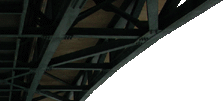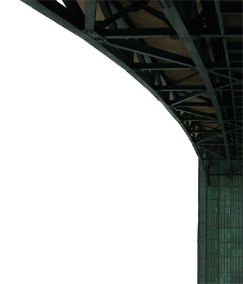

 






|
Discovering and
Preserving Hoosier Heritage
Dr. James L. Cooper

Indiana’s
under-stated beauty of gently rolling hills, patch-work fields,
and timber stands broken by ambling creeks and modest rivers
nourishes a quiet, down-home, rural lifestyle long associated
with “Hoosiers.” For a century and a half, however, rural
Indiana has been increasingly complemented by urban development.
From the holler to the farmstead, to the small town, and to the
city center, a wealth of diverse spans has enriched Indiana’s
natural and man-made landscapes. Much remains wonderfully
available for discovery and exploration.
The bites and images on this site offer snapshots that arise
from considerable rummaging through records and wandering in a
pickup truck across Indiana for nearly three decades. You will
find a pronounced passion for the stories we have found – a
passion which reaches beyond Indiana’s historic bridges
understood as nostalgic Linus blankets or as easy avenues into
an imagined, simpler rural past. Instead, we will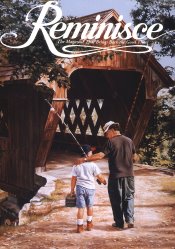 explore the varied and extensive inventiveness of our
designer and artisan forbears with the various materials
available when, in ages unlike our own, risk-taking and
efficient use of materials were practiced and honored.
explore the varied and extensive inventiveness of our
designer and artisan forbears with the various materials
available when, in ages unlike our own, risk-taking and
efficient use of materials were practiced and honored.
Today’s
covered bridge festivals and coffee-table picture books
undervalue the rich heritage of design and construction
represented by the timber spans which once graced our
roadways. Inventive elements are under the covers, if
the visitor is troubled enough to look inside. The
trusses speak to the great skill of the bridge-building
carpenters and blacksmiths once prominent in Indiana. In
the world of preservation, surviving Hoosier spans are
akin to the preserved houses of notable White Men. The
unroofed, low, and often unsided smaller timber trusses
and the trestle spans that provided the majority of the
bridges in any Indiana county before 1880 are now, like
worker housing, all gone.

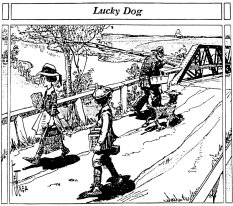 The
Iron Horse that knit together the increasingly industrial
workshops of the eastern United States following the Civil War
gradually changed Hoosier bridge trusses from timber to iron
and, from about 1890 onward, to steel. The earliest iron bridges
erected in Indiana were typically designed and fabricated in
Ohio, sent by rail to the train station closest to the erection
site, and then raised on foundations which local masons prepared
for the imported metal superstructure. Hoosier
designer-engineers soon invented some or their own truss formats
and iron workers developed a home-grown metal fabricating
industry which came to serve both Indiana and, in time, many
sites to the south and west. Buried in the under-maintained,
often-rusting metal bridges that may look like scrap heaps
sitting on the back 40 are stories of creative genius worth
uncovering and recounting.

| |
Friendship Bridge, Ripley County |
|
 |
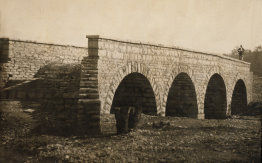 |
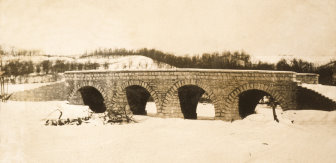 |
Falsework for supporting
arch and ginpole for lifting limestone block.
|
Stonework complete without
fill in 1909. |
1913 Postcard.
|
| |
|
--photos
courtesy of Ripley County Historical Society |
To
claim any considerable innovative design for the local
masons who laid up hundreds of stone arches, clams, and
clappers in the Indiana countryside or city would be to
undervalue invention as old as the Romans. But the
craftsmanship of many local Hoosier stone-cutters and
masons whose work is still exhibited in extant stone
structures on our highways is in league with that of the
Romans. Indiana stands second to none in the quarrying
and working of dimension Oolitic limestone used widely
to face monumental buildings across the United States.
The bridge-builders, however, rather largely relied on
the harder, blue, Laurel, or Niagara limestone quarried
mostly in the southeastern part of the state.

Concrete
bridges worked especially well in Twentieth Century cities
anxious to soften their gritty industrial image and to emphasize
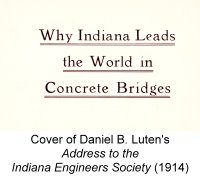 civic
space. In the world of concrete bridge design and
construction Indiana has national significance. Its own Daniel
B. Luten held more patents on design and construction methods
early in the Twentieth Century than all other
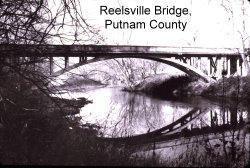 Americans
combined. Luten-design could be found not only across Indiana,
but in tens of thousands of spans across the U.S.A., Canada, and
Mexico.

To honor the Hoosier spanned heritage discovered and explored,
we should strive to preserve as much of it as is possible and
practical. We are enriched by its beauty, rewarded with the
diverse community identities it bestows, and nurtured against
cultural amnesia through active connection with our roots.
Preservation means much more than keeping historic bridges in
the service for which they were designed as long as possible. It
also includes resistance to remodeling and transforming that
heritage into something else by replacement one bridge member at
a time. We need not live in a world of heritage mirage and
Disneyland make believe when in-kind repairs can retain the
original design and respect the original craftsmanship, often at
a fraction of the cost of replacing it.

|
 |
|

